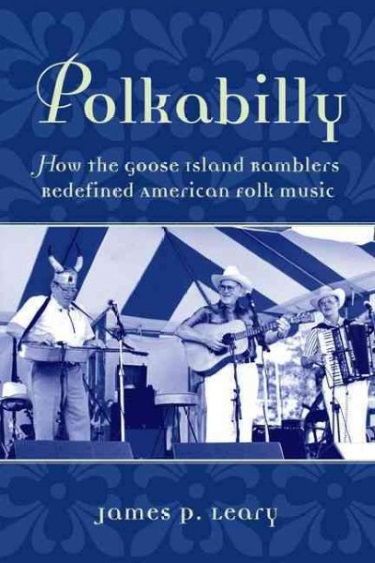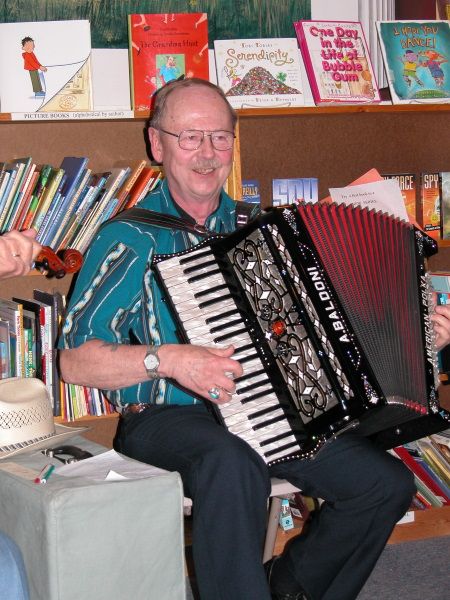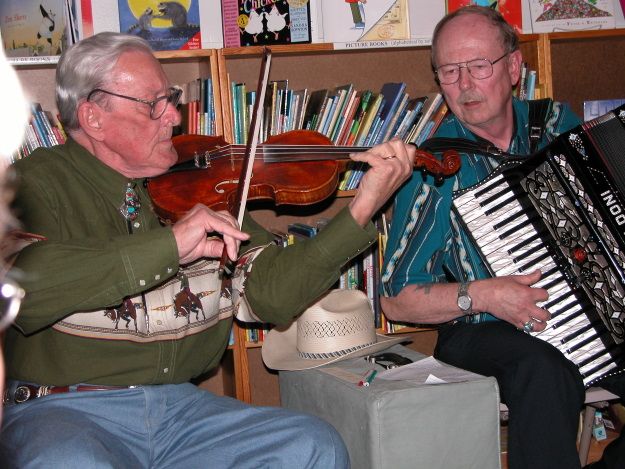The group started out in the early 1960s playing at a tavern called Glen and Ann's, which is now the Nitty Gritty. "Uncle Windy" Whitford, "Smokey George" Gilbertsen, and Bruce Bollerud entertained audiences for years playing a mix of hillbilly and Wisconsin folk music. Windy passed away in 2000 so the night was George and Bruce playing fiddle and accordion, respectively.
I pulled into town and found the Prairie Bookstore. It was small but warm and the children's book area in back was setup with chairs. Walking in, I found that Bruce and George were tuning up. Bruce had his accordion and George turned to me and joked that he was their first accordionist. Professor Leary was chatting with a couple folks and a couple guys were setting up a video camera and a mic to record the night. A mostly older crowed slowly drifted in and it became clear very early that a lot of these people knew Bruce and George. Folks chatted with the band and a line formed to get copies of Polkabilly signed as well as to buy cassettes and videotapes. I mentioned to Professor Leary that my polka ramblings led to the article in Isthmus and he remarked that he enjoyed my writing. Perhaps there is a career for me in folklore! At one point, an old high school classmate of Bruce's came up and said hello. Everyone seemed to know one another from back in the day and it felt almost like a family gathering.
With a few stragglers still in line for autographs, Professor Leary began the evening by telling us why he wrote the book. He talked about growing up in Rice Lake. For those unfamiliar with Wisconsin, Rice Lake is a small town in the upper northwest part of the state. As a kid, Leary listened to WJMC, a local radio station, and heard lots of different kinds of music. In addition to pop standards, there was much that was representative of the upper Midwest: Scandinavian dance music, the Polish Barn dance, a bit of yodeling, et al. This was the folk music of the largest ethnic groups that settled Wisconsin – Germans, Poles, and Scandinavians. But there was also plenty of music to be had around town and he lovingly recalled the Buckhorn tavern where fiddlers would gather to play on the familiar 4-string variety as well as the Norwegian Hardanger fiddle. Leary noted the wonderful musical mixing up nort. Not only did the whites learn from other whites but there was also a 2-way influence between the Native Americans and the white folk. All of these people trading techniques and songs created quite a heady musical brew.
Despite the diversity of cultures contributing their music to the brew, Leary noted how academia has largely ignored the folk music of the upper Midwest. Long ago the definition of American folk music became that of the music derived from the British Isles and later from former slaves. The sound of American folk is normally thought of as the sound of Appalachia and the Mississippi Delta. Leary thinks this is a tragic state of affairs and his book is an attempt to show the wonderful diversity of the equally American folk music found in the upper Midwest and perhaps start a process where the music will get the respect it deserves. And, for him, the Goose Island Ramblers epitomize the variety of styles to be found here. With his introduction over, he handed the reins over to George and Bruce.
They played a spirited, if short, set and told stories in between songs. Bruce talked about how he grew up on a farm and that many of the farmhands were from Norway. One of them told him that, if he wanted to learn how to yodel, he had to eat grass. And so, much to his mother's chagrin, Bruce ate grass. He also told us how he inherited a massive collection of 78s from a neighbor. George recalled playing at schoolhouses in a trio when he was 8 or 9. Later on, he left the area and traveled the world - Asia and the Pacific Rim during World II – playing music.
They played a number of songs including their most famous tune, "No Norwegians in Dickeyville". If I recall correctly, they opened their set with "Going to Mt. Horeb For a Beer or Two". There was a polka in there as well.




No comments:
Post a Comment